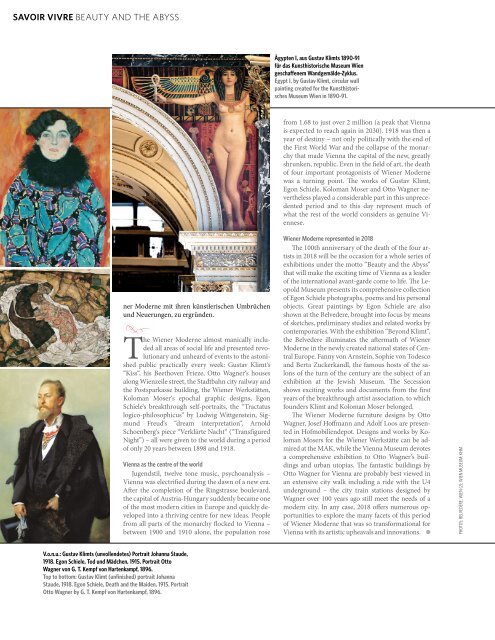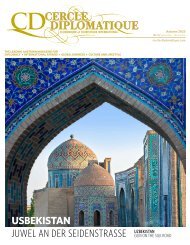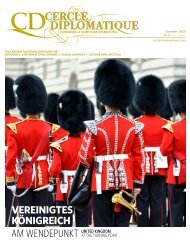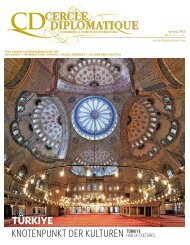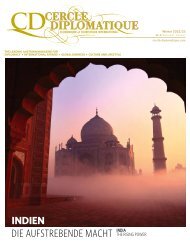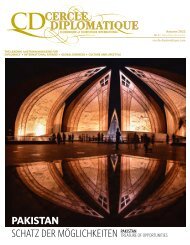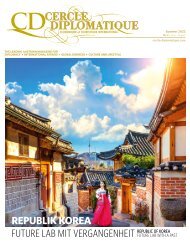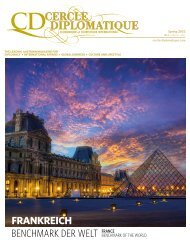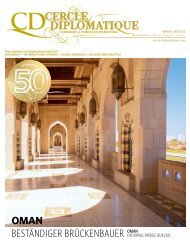CERCLE DIPLOMATIQUE - issue 4/2017
CD is an independent and impartial magazine and is the medium of communication between foreign representatives of international and UN-organisations based in Vienna and the Austrian political classes, business, culture and tourism. CD features up-to-date information about and for the diplomatic corps, international organisations, society, politics, business, tourism, fashion and culture. Furthermore CD introduces the new ambassadors in Austria and informs about designations, awards and top-events. Interviews with leading personalities, country reports from all over the world and the presentation of Austria as a host country complement the wide range oft he magazine.
CD is an independent and impartial magazine and is the medium of communication between foreign representatives of international and UN-organisations based in Vienna and the Austrian political classes, business, culture and tourism. CD features up-to-date information about and for the diplomatic corps, international organisations, society, politics, business, tourism, fashion and culture. Furthermore CD introduces the new ambassadors in Austria and informs about designations, awards and top-events. Interviews with leading personalities, country reports from all over the world and the presentation of Austria as a host country complement the wide range oft he magazine.
Create successful ePaper yourself
Turn your PDF publications into a flip-book with our unique Google optimized e-Paper software.
SAVOIR VIVRE BEAUTY AND THE ABYSS<br />
Ägypten I, aus Gustav Klimts 1890-91<br />
für das Kunsthistorische Museum Wien<br />
geschaffenem Wandgemälde-Zyklus.<br />
Egypt I, by Gustav Klimt, circular wall<br />
painting created for the Kunsthistorisches<br />
Museum Wien in 1890-91.<br />
INFO<br />
V.o.n.u.: Gustav Klimts (unvollendetes) Portrait Johanna Staude,<br />
1918. Egon Schiele, Tod und Mädchen, 1915. Portrait Otto<br />
Wagner von G. T. Kempf von Hartenkampf, 1896.<br />
Top to bottom: Gustav Klimt (unfinished) portrait Johanna<br />
Staude, 1918. Egon Schiele, Death and the Maiden, 1915. Portrait<br />
Otto Wagner by G. T. Kempf von Hartenkampf, 1896.<br />
ner Moderne mit ihren künstlerischen Umbrüchen<br />
und Neuerungen, zu ergründen.<br />
The Wiener Moderne almost manically included<br />
all areas of social life and presented revolutionary<br />
and unheard of events to the astonished<br />
public practically every week: Gustav Klimt‘s<br />
“Kiss“, his Beethoven Frieze, Otto Wagner‘s houses<br />
along Wienzeile street, the Stadtbahn city railway and<br />
the Postsparkasse building, the Wiener Werkstätten,<br />
Koloman Moser‘s epochal graphic designs, Egon<br />
Schiele‘s breakthrough self-portraits, the “Tractatus<br />
logico-philosophicus“ by Ludwig Wittgenstein, Sigmund<br />
Freud‘s “dream interpretation“, Arnold<br />
Schoenberg‘s piece “Verklärte Nacht“ (“Transfigured<br />
Night”) – all were given to the world during a period<br />
of only 20 years between 1898 and 1918.<br />
Vienna as the centre of the world<br />
Jugendstil, twelve tone music, psychoanalysis –<br />
Vienna was electrified during the dawn of a new era.<br />
After the completion of the Ringstrasse boulevard,<br />
the capital of Austria-Hungary suddenly became one<br />
of the most modern cities in Europe and quickly developed<br />
into a thriving centre for new ideas. People<br />
from all parts of the monarchy flocked to Vienna –<br />
between 1900 and 1910 alone, the population rose<br />
from 1.68 to just over 2 million (a peak that Vienna<br />
is expected to reach again in 2030). 1918 was then a<br />
year of destiny – not only politically with the end of<br />
the First World War and the collapse of the monarchy<br />
that made Vienna the capital of the new, greatly<br />
shrunken, republic. Even in the field of art, the death<br />
of four important protagonists of Wiener Moderne<br />
was a turning point. The works of Gustav Klimt,<br />
Egon Schiele, Koloman Moser and Otto Wagner nevertheless<br />
played a considerable part in this unprecedented<br />
period and to this day represent much of<br />
what the rest of the world considers as genuine Viennese.<br />
Wiener Moderne represented in 2018<br />
The 100th anniversary of the death of the four artists<br />
in 2018 will be the occasion for a whole series of<br />
exhibitions under the motto “Beauty and the Abyss“<br />
that will make the exciting time of Vienna as a leader<br />
of the international avant-garde come to life. The Leopold<br />
Museum presents its comprehensive collection<br />
of Egon Schiele photographs, poems and his personal<br />
objects. Great paintings by Egon Schiele are also<br />
shown at the Belvedere, brought into focus by means<br />
of sketches, preliminary studies and related works by<br />
contemporaries. With the exhibition “Beyond Klimt“,<br />
the Belvedere illuminates the aftermath of Wiener<br />
Moderne in the newly created national states of Central<br />
Europe. Fanny von Arnstein, Sophie von Todesco<br />
and Berta Zuckerkandl, the famous hosts of the salons<br />
of the turn of the century are the subject of an<br />
exhibition at the Jewish Museum. The Secession<br />
shows exciting works and documents from the first<br />
years of the breakthrough artist association, to which<br />
founders Klimt and Koloman Moser belonged.<br />
The Wiener Moderne furniture designs by Otto<br />
Wagner, Josef Hoffmann and Adolf Loos are presented<br />
in Hofmobiliendepot. Designs and works by Koloman<br />
Mosers for the Wiener Werkstätte can be admired<br />
at the MAK, while the Vienna Museum devotes<br />
a comprehensive exhibition to Otto Wagner‘s buildings<br />
and urban utopias. The fantastic buildings by<br />
Otto Wagner for Vienna are probably best viewed in<br />
an extensive city walk including a ride with the U4<br />
underground – the city train stations designed by<br />
Wagner over 100 years ago still meet the needs of a<br />
modern city. In any case, 2018 offers numerous opportunities<br />
to explore the many facets of this period<br />
of Wiener Moderne that was so transformational for<br />
Vienna with its artistic upheavals and innovations.<br />
PHOTOS: BELVEDERE, WIEN (2); WIEN MUSEUM; KHM<br />
AUSSTELLUNGS-HIGHLIGHTS 2018, SCHÖNHEIT UND ABGRUND / WIENER MODERNE | EXHIBITION HIGHLIGHTS BEAUTY AND THE ABYSS I WIENER MODERNE<br />
Klimt ist nicht das Ende. Aufbruch<br />
in Mitteleuropa.<br />
Unteres Belvedere, 22.3.–26.8.2018<br />
belvedere.at<br />
Egon Schiele – Wege einer<br />
Sammlung<br />
Belvedere Orangerie, 19.10.2018–<br />
17.2.2019<br />
belvedere.at<br />
Die nackte Wahrheit. Klimt<br />
konfrontiert.<br />
Kunsthistorisches Museum Wien,<br />
voraussichtlich März–September 2018<br />
khm.at<br />
Stairway to Klimt<br />
Kunsthistorisches Museum Wien,<br />
13.2.–2.9.2018<br />
khm.at<br />
Otto Wagner<br />
Wien Museum, 15.3.-7.10.2018<br />
wienmuseum.at<br />
Koloman Moser<br />
MAK – Österreichisches Museum für<br />
Angewandte Kunst/Gegenwartskunst,<br />
20.12.2018–22.4.2019<br />
mak.at<br />
Egon Schiele. Expression und Lyrik<br />
Leopold Museum, 23.2.-4.11.2018<br />
leopoldmuseum.org<br />
Arnstein, Todesco, Zuckerkandl.<br />
Gastgeberinnen und ihre Salons<br />
zwischen Kunst und Politik.<br />
Jüdisches Museum Wien, 24.4.-<br />
30.9.2018<br />
jmw.at<br />
Wagner, Hoffmann, Loos und das<br />
Möbeldesign der Wiener Moderne.<br />
Hofmobiliendepot, 21.3.-7.10.2018<br />
hofmobiliendepot.at<br />
Berg, Wittgenstein, Zuckerkandl.<br />
Drei Zentralfiguren der Wiener<br />
Moderne. Literaturmuseum, ab April<br />
2018<br />
onb.ac.at<br />
Ludwig Wittgenstein: Die Tractatus<br />
Odyssee (100 Jahre Tractatus<br />
Logico-Philosophicus)<br />
Bulgarisches Kulturinstitut „Haus<br />
Wittgenstein“, 15.10.-30.11.2018<br />
haus-wittgenstein.at<br />
Die Salonkultur des alten Wien –<br />
Glanzvolle Bühne einer Gesellschaft<br />
Ernst Fuchs Museum (Otto Wagner<br />
Villa), Juni-September 2018<br />
ernstfuchsmuseum.at<br />
Adolf Frohner, Hochzeit der Schwestern (Detail), 1967, Sammlung Gabriel, Foto: Christian Redtenbacher<br />
Klimt Villa<br />
Führungen 2018: „Gustav Klimt, Leben<br />
und Werk“, „Internationaler Jugendstil“,<br />
„Japonismus“ u.a. (Termine auf Anfrage<br />
und auf der Webseite<br />
klimt.at<br />
FOKUS<br />
FROHNER<br />
DIE SAMMLUNG GABRIEL<br />
15.10.<strong>2017</strong>–08.04.2018


